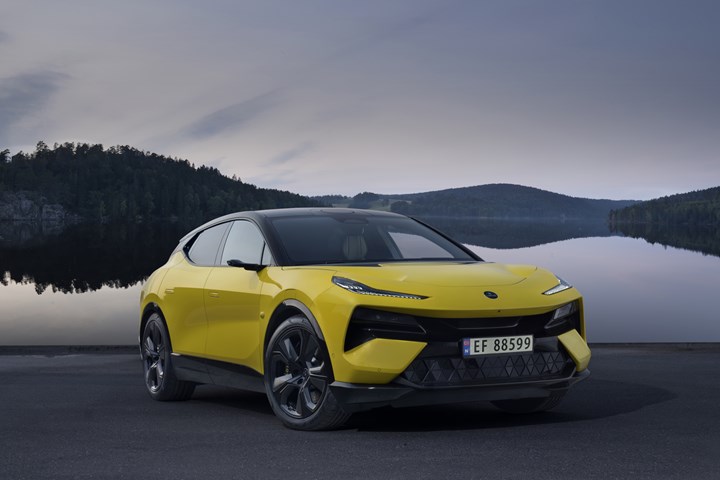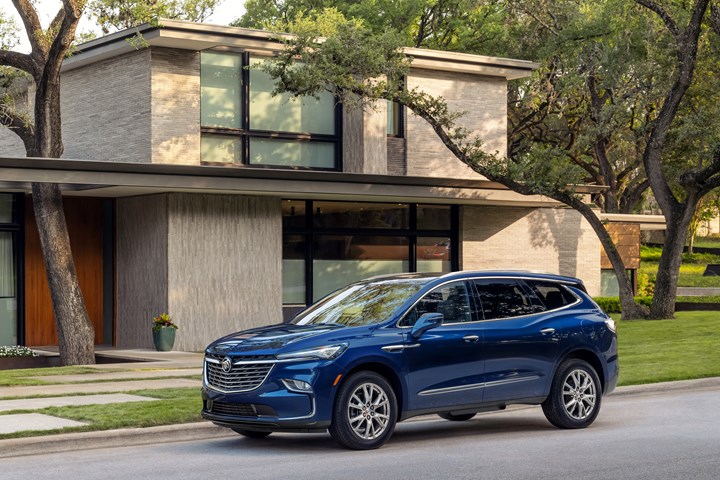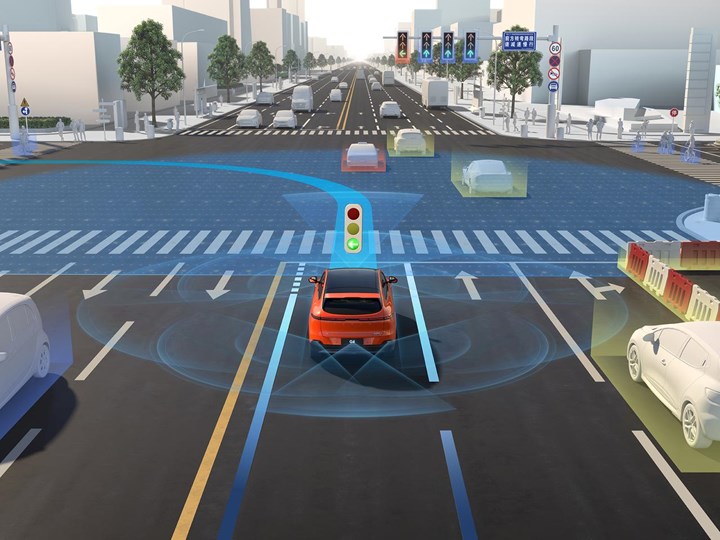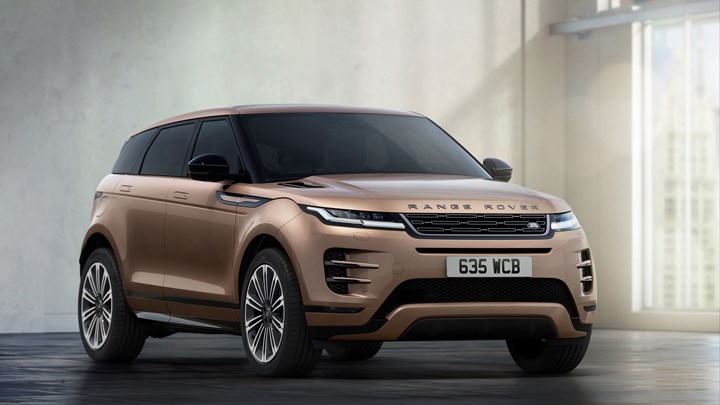on Lotus going SUV & the industry going back to normal (more or less)
Lotus SUV EV. . .trust & trends. . .returning to normal. . .competition is different in China. . .the air is cleaner in the Evoque. . .
About the Lotus Eletre

Who would have imagined that Lotus would make an SUV? Yet it has, the Eletre. It is, by the way, an EV. (Image: Lotus)
When Porsche introduced the Cayenne in 2002, there was considerable consternation among some of the Porsche faithful: An SUV! What they may not have recognized at the time was that the 1990s were not kind to Porsche, as the company started the decade in the red. The Boxster, introduced in 1996, a more economical sports car, helped with the company’s fortunes. But it needed to do more. And decisions had to be made mid-decade. The people in Porsche U.S. sales recommended to Stuttgart: Build an SUV.
And so the Cayenne was launched and things have been on the upswing.
Globally, in 2022, the #1 model sold: the Cayenne. It accounted for 95,604 of the company’s total 309,884 deliveries.
The #2 model for Porsche: the Macan, with sales of 86,724 units. The vehicle, introduced in 2014, is a compact SUV.
(“The 911?,” you wonder. 40,410 deliveries.)
Presumably there are those who are members of the Colin Chapman Fan Club have the same thought about the Lotus Eletre, which goes on sale in Europe and the UK this summer. It is supposed to be coming to the U.S. late next year.
It is presently available in China. After all, it is being built in Wuhan.
Yes, the Eletre is an SUV. An electric SUV, but still. . .
A couple points:
- Lotus, which became part of Geely Automotive in 2017, has been a niche player--~5,000 units per year—that plans to go 150,000 by 2028
- While the U.S. is certainly a market for the marque, given the popularity of SUVs in America, a company that wants to gain sales needs to have. . . yes an SUV.
For Whom
How Lotus is positioning the Eletre:
“It’s aimed at a new generation of Lotus customers; those who value the world-class dynamic performance and striking design which have always been part of the Lotus experience, and who also need a practical, versatile and spacious family-focused vehicle – one that’s packed with the latest digital technology to make their driving life safer and more convenient.”
Let’s face it: for all of its striking looks and performance, the Lotus Emira has two seats, which limits it to a two-person family, and in terms of practicality, it offers 7.3 cubic feet of cargo room behind the seats and an additional 5.3 cubic feet in the trunk: that’s less than the size of the F-150 Lightning’s frunk: 14.1 cubic feet.
Lighter Like a Lotus
Colin Chapman’s approach to vehicle engineering is encompassed in his quote:
“Simplify, then add lightness.”
The Eletre has a 112-kWh lithium-ion battery and permanent magnet electric motors on the front and rear axles (providing 603 hp or 905 hp, depending on trim). The vehicle is 201 inches long, 87.8 inches wide, and 64 inches high. It seats four or five.
A five-seater has 23.6 cubic feet of cargo capacity with seats up, and 54 cubic feet if the second row is folded.
And there is a 1.6-cubic foot frunk.
The curb weight starts at 5,490 pounds and goes beyond 5,820 pounds (depending on trim and accessories).
It Could Have Been Heavier
The Eletre uses a Lotus-specific Electric Premium Architecture (EPA). Lotus calculates that through the use of a mixed-material approach the body structure weighs 10% less than it would have been without the targeting.
There is an extensive use of aluminum for the vehicle: it accounts for 43% of the platform and 50.7% of the complete body structure.
Two aluminum high-pressure die castings are used for the front damper mounting points. They provide a weight savings of 13.2 pounds compared with steel.
But steel—ultra-high strength and hot-formed—is used.
The hood is a three-piece aluminum assembly that saves 17.6 pounds. The frameless aluminum doors save 13.2 pounds.
No Sylph
All that said, a Model Y, which is a bit smaller, is much lighter, with a curb weight for an AWD version starting at 4,393 pounds.
///
Wouldn’t You Really Rather Have a Buick? (And the Tesla Effect)

The 2023 Buick Enclave. People really like their Buicks. (Image: Buick)
Sometimes people wonder why Buick continues to exist for reasons that go beyond the “because it is really popular in China” argument. Yes, there are more Buicks sold in China than the U.S.: last year 677,938 vehicles vs. 103,519. But the bloom is somewhat off the proverbial rose for Buick in China, as it is now in 12th place, whereas it was in the top 5 not that long ago.
However, in the U.S. the brand is doing better than it did last year, with its Q2 2023 sales—42,752 vehicles—being a 47.8% increase over Q2 2022.
What’s more, it outsold Cadillac in Q1 in the U.S., which delivered 38,877 vehicles.
Loyalty Matters
However, during the S&P Global Mobility 2023 Loyalty Trends and Migration Patterns presentation, Tom Libby, the firm’s associate director and Loyalty principal, pointed out something that is quite valuable about Buick.
Looking at what Buick owners do when they return to market, Libby said that for the first quarter of 2023 45.8% got another Buick.
But the data also show, Libby said, that 70.4% of Buick owners buy something is within the General Motors portfolio.
The brand is sticky.
While Chevrolet has more brand loyalty among those returning to market—57.1% compared with Buick’s 45.8%--Buick outperforms Chevy when it comes to staying with GM, as Chevy is at 67.3%--a solid number, but less than Buick’s 70.4%.
And We Can’t Overlook Tesla
When looking at brand loyalty among the luxury marques, Libby made a remarkable point: there is no brand—not BMW, Mercedes, Lexus, Cadillac, Porsche, etc.—that is above 50% when it comes to return-to-market loyalty (calendar-year-to-date) other than. . .Tesla.
Which is at 68%.
This means that for all of the other luxury brands, when customers go to buy a new vehicle, more than half are not going to buy the brand they currently have.
Yes, the brands lose more than 50% of their customers.
Except Tesla.
Where Do They Go?
The luxury brands contributing most to Tesla’s success include Acura, Alfa-Romeo, Genesis, Lexus, and Mercedes.
Even the mainstream brands contribute, as Libby pointed out that there are defections to Tesla from every marque with the exception of Fiat. (As Fiat sold 138 vehicles through Q1 of 2023, even if there was large-scale defection it would still be small.)
However, even though Tesla’s loyalty towers over other luxury brands, Libby noted that looking at brand loyalty in April 2023 and comparing it with April 2022, there are several companies that have increased their loyalty above the 1.1% that Tesla achieved.
These include:
- Land Rover: 9.5%
- Audi: 8.3%
- Infiniti: 6.9%
- Porsche: 5.7%
- Volvo: 3.7%
- Acura: 2.5%
- Maserati: 1.5%
- Cadillac: 1.3%
Still, there’s Tesla.
Fuel, Too
And the Tesla Effect is even quite discernable in an assessment of loyalty to powertrain types.
That is, overall S&P Global Mobility found that U.S. EV owners are loyal to EVs, with a loyalty of 67.8%.
However, take Tesla out of the calculations and that goes down to 49.7%.
Clearly the other OEMs have a lot of work to do if they want to move more EVs.
///
The Return to Normal Is Starting Now

The Tesla Model 3 and a camel. Yes, Tesla does keep things somewhat confusing. (Image: Tesla)
On the subject of research. . .
Jonathan Smoke, chief economist for Cox Automotive, during a mid-year briefing of the state of the auto market last week, said he anticipates that were someone to look back a year from now to today they’d think, “That was the beginning of returning to normal.”
However, lest someone think that the normalcy would be an industry back in the 17-million sales, Smoke noted, “I am not saying that we’re on the cusp of exciting growth ahead.”
Still, things are going to improve, the calculators at Cox expect.
Charlie Chesbrough, Cox senior economist, said that whereas they had previously projected 2023 sales to be 14.2 million, they’ve adjusted that upward to 15 million. (This would be 12.4 million retail and 2.6 million fleet sales.)
Smoke said that the largest problem vis-à-vis demand is vehicle affordability.
This is something he said is particularly affecting sales of electric vehicles: “What we see in research is that the price of vehicles remains the number-one issue.”
While there are new EV models of varying types being produced by an increasing number of OEMs, Cox is finding that the pace of sales is not keeping up with the vehicles being built.
“If You Build It. . .”
Jonathan Gregory, Cox senior manager, Economic and Industry Insights, described the situation as the automakers having a “’Field of Dreams’ moment”: if they build them, people will buy.
However, in Q2 2023 there was a 92.2-day supply of EVs, 92,285 vehicles waiting to find homes.
Smoke suggested progress is being made to move more EVs through things like the IRA tax credits. He pointed out that the EV market is going through growing pains and he anticipates that there will be many such pains going forward.
And he thinks there will likely be more discounting in the EV space to make more of the vehicles more attainable by more people.
According to Cox, the average retail price of an EV in Q2 ’23 was $55,436, which is down notably from Q2 ’22, when it was $65,560. However, a non-trivial amount of change was predicated by Elon Musk’s sudden downward price adjustments, which led other OEMs to follow his lead. The comparative stability and predictability of the market (global pandemics notwithstanding) seem to be less so in the EV space.
As Michelle Krebs, Cox executive analyst, put it: “Tesla keeps things confusing.”
///
The Disadvantage of the Status Quo

The XPENG G6 features what the company describes as “full-scenario ADAS. . .empowered by China’s first BEV+ Transformer based deep visual neural network XNet.” An evident focus on tech. (Image: XPENG)
“Unlearning” is an important thing that designers, engineers and their superiors at what are now known as “legacy” auto companies must embrace if they’re going to compete successfully with (comparatively) new companies like Tesla.
That is a recommendation that Mathew Vachaparampil, CEO, Caresoft Global, recently made on an edition of “Autoline After Hours.”
Caresoft is a company that provides teardowns, benchmarking and engineering services, including doing a high-energy scan of vehicles (think of a human CAT scan) that provides digital information that can be used for precise analysis.
Vachaparampil said there are ways that the traditional OEMs do things that simply aren’t as efficient as their new competitors—for example a cross-car beam for a traditional company weighs 9.1 kg while the one developed by a new OEM comes in at just 6.5 kg and is much simpler overall, which enhances manufacturability.
And that’s just a simple example. Think of an array of other elements that go into a vehicle.
But there are set processes in place that people at the legacy companies follow because, well, those are set processes.
The Chinese Approach
Another voice for doing thing differently was heard last week.
Dr. Stephen Dyer, co-leader of AlixPartners’ Greater China business and head of the firm’s Asia Automotive and Industrials consulting practice, said in a briefing that Chinese automotive brands are doing “much better on delivering what Chinese consumers want” than brands from other parts of the world.
Why does what the Chinese consumers want matter?
There is the fact that Western companies—GM, Ford, VW, etc.—are all in that market. (For the VW Group it is the single largest market: yes, bigger than Germany.)
Heretofore, Western brands were doing well in China, but their sales are diminishing. AlixPartners analysis has it that not only will Chinese brands outsell foreign brands this year, but by 2030 they will command 65% of the market.
In addition, China is now the world’s biggest auto exporter, so presumably Chinese OEMs are going to develop for the home market first, then use that as the basis for what they send to the rest of the world.
Dyer said that especially in the electric vehicle space people at Chinese OEMs are taking a different approach to vehicle development:
- Vehicle attributes: The traditional OEMs are engineering-driven, concentrating on historic vehicle attributes like ride-and-handling and NVH. The Chinese OEMs are new tech-driven, providing an array of ADAS and infotainment features (and styling), while going for “good enough” on the traditional attributes the traditional OEMs focus on.
- Business setup: The traditional OEMs are focused on defending their business—which includes both ICEs and EVs, as well as the well-established dealer sales channel. The Chinese companies have a “usurper mindset,” which is focused on EVs (there isn’t necessarily a need to figure if they’re going to make any investments in ICEs) and there are direct-to-consumer sales models established.
- Approach to speed and risk: The traditional work to get it right in order to mitigate risk, results in more time being required for vehicle development. The Chinese companies have risk appetites that are associated with startups: speed to market is key, so there is a more-extensive use of things like digital development tools and modeling in lieu of physical prototypes.
The point is: new competitors, whether they’re based in the U.S. or elsewhere, are doing things in an entirely different way.
While there is something to be said for tradition and caution, there is arguably more to be said to changing the way things are done in order to maintain a level of competitiveness.
Which can mean unlearning.
///
The Evoque Helps You Breathe Easier

The 2024 Evoque. The air quality on the inside is much better than it is outside. (Image: Range Rover)
The 2024 Range Rover Evoque is a handsome compact SUV.
Gerry McGoven describes the styling: “sophisticated design and timeless sense of modernity.” He is slightly biased as he is the chief creative officer of JLR, the company previously known as “Jaguar Land Rover.”
An interesting thing about McGovern: he gets to put “O.B.E.” after his name. The man who has styled vehicles for Chrysler, Peugeot, Rover, and Lincoln, rejoined Land Rover in 2004 as director of Advanced Design, and has gone upward through the ranks.
He became Officer of the Order of the British Empire in 2004.
But that aside. . .
The Evoque has an available feature that is on the one hand beneficial but on the other somewhat unusual:
- A Comfort Pack that includes PM 2.5 Filtration and CO2 Management. It is activated by selecting the Purify button on the Air Quality page in the vehicle’s Pivi Pro infotainment system.
According to JLR:
“It uses nanoe X technology to combat pathogens and help significantly reduce odours, bacteria and allergens, while the Air Quality Index (AQI) app technology allows clients to monitor outside air quality at their location and their destination on screen.”
Who would have thought just a few years back that addressing pathogens and bacteria would be part of taking a ride in a vehicle?
~~~
RELATED CONTENT
-
On Automotive: An All Electric Edition
A look at electric vehicle-related developments, from new products to recycling old batteries.
-
Aluminum Sheet for EV Battery Enclosure
As the number of electric vehicles (EVs) is about to increase almost exponentially, aluminum supplier Novelis is preparing to provide customers with protective solutions
-
Revolutionary Hydrogen Storage Tank Design Could Propel H2 Deployment
Rather than storing hydrogen in a large cylindrical tank, Noble Gas has developed a conformal system


.jpg;width=70;height=70;mode=crop)






